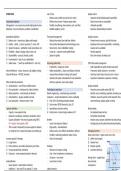OPERATIONS Just In Time Quality control
- Reduce waste as little stock (arrives for order) - Inspector checks finished goods (responsible)
Operational objectives - Efficient stock control = Kanban repeat orders - Detect errors that are unavoidable
Management = use resources to provide right goods/services - Flexible, low pilferage, low inventory costs, cash flow - Unbiased specialists
Objectives = focus for decisions, yardstick, coordination - Reliable suppliers, no EoS - Expensive, demotivating for workers
Operational objectives Time based management Quality assurance
1) Reduce costs – lower prices, higher profit margin - Reduce time wasted, low lead time, efficient - Prevent errors in process, right the first time
2) Quality – satisfy, ↓ returns, punctual, ↑ prices, USP - Short product development with technology, innov - Employees check work (responsible) = motivating
3) Speed of response – satisfaction, loyal, lower labour cost - Need comms, trust, multiskilled, training - Assumes errors avoidable
4) Flexibility – adapt to change, reduce costs, cost - Comp adv – customer needs satisfied faster - Modern approach
5) Dependability – punctual, durable, quality - Speed not quality - Bias, time wasted, retraining costs
6) Environmental – duty of care, stakeholders
7) Added value – ↑ worth by modification (R – mat cost) Improving productivity TQM Total quality management
- Productivity = output per worker - Staff responsible for quality in dept (assurance)
Internal influences – nature, resources, obj, budget, training - Higher productivity ↓ labour costs (labour intensive - Teamwork, satisfy customers + co-workers
External influences – PESTLEC, demands - Improved by motivation, training, tech (speed) - Good rep, fewer faulty, decrease costs + returns
- Quantity not quality, redundancies if more productive - Long time to implement, expensive, retraining
Affect method of production with less, expensive, more waste output
1) Job production – one off items, skilled workers Quality standards
2) Flow production – continuous line, labour divisions Technology in operations - Awards to prove quality system (BS, ISO)
3) Batch production – small amounts of identical Robotic engineering – manufacturing, automation - Benefits: use in marketing, reputation, branding, mo
4) Cell production – groups complete set tasks Computers – product development, comms, marketing - Problems: assess the system not the standard, time,
5) Lean production – minimum waste + time 1) CAD, CAM, 3D printing prototype cheaper need monitoring, regular update, training
2) Stock control, EPOS (electronic), data, JIT
Capacity utilisation 3) Spreadsheets, decision making Benchmarking
- Capacity = max output in time 4) Email comms + internet target audience 24/7 - Set standards based on best
- Depends on employees, machinery, production, invest - Not all ideas transferable
- Capacity utilisation = how much capacity using (90%) Benefits - Analyse comp, compare, implement to close perf gap
CU = output / max capacity x 100 - Lower costs long term (labour) - Strategic/process/funcation/internal benchmarking
- 90% as need to temporarily increase supply for demand, - High quality – standardisation
no margin of error, surplus stock oppo cost working cap - Reduce waste, more efficient (marketing + delivery) Managing inventory
- Flexible in switching production, better comms Stock control chart = register stock over a time
Increase capacity if shortage - Safer, less boring jobs 1) Buffer stock (surges)
1) Longer hours 2) Reorder level
2) More machines, more labour (temporary, part time) Problems 3) Reorder quantity
3) Increase productivity, motivation - Resistance to change, training 4) Lead time (delivery)
4) Outsource – meet unexpected peaks in demand - Cost + time to implement, maintenance
- Job losses – low morale Reorder level – supplier lead
Underutilisation - Low barriers of entry time, demand,
- Spare capacity = output below maximum consequence
- Inefficient, ↑ unit cost (FC less spread), ↑ prices Labour intensive




